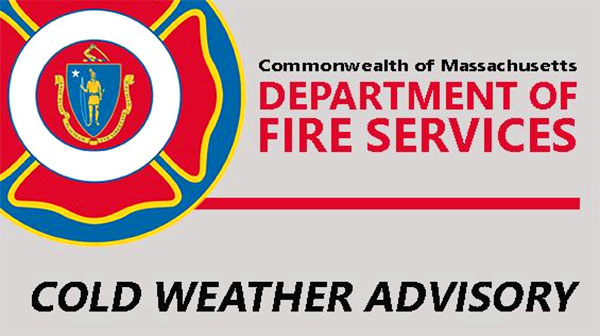
Cold Weather Advisory: Practice Home Heating Safety During Cold Snap
A Press Release from the Massachusetts Department of Fire Services – Avoid Fire and Carbon Monoxide Hazards
Space Heater Safety Brochure – CLICK HERE
Winter Home Heating Safety Brochure – CLICK HERE
Keep Warm Keep Safe – 20 page e-book CLICK HERE
STOW — With bitter cold temperatures heading our way, State Fire Marshal Peter J. Ostroskey is reminding residents to “Keep Warm, Keep Safe” and avoid fire and carbon monoxide hazards while heating their homes this week.
“Smoke and carbon monoxide alarms are your first line of defense,” State Fire Marshal Ostroskey said. “They should be installed on every floor of the residence and tested monthly to be sure they’re working properly. If an alarm is ‘chirping’ due to low batteries, replace the batteries right away – don’t disable the alarm. If the alarm is more than 10 years old, it’s time to replace it.”
Space Heaters
“It’s important to keep space heaters at least three feet from curtains, bedding, and anything else that can burn,” State Fire Marshal Ostroskey said. “Plug them directly into a wall socket, not an extension cord or a power strip, and remember that they’re for temporary use. Always turn a space heater off when you leave the room or go to sleep.”
When purchasing a space heater, select one that’s been tested and labeled by a nationally recognized testing company, such as Underwriters Laboratories (UL). Newer space heaters should have an automatic shut-off switch that turns the device off if it tips over. Unvented kerosene space heaters are illegal for sale and use in Massachusetts, officials said: the risk of fire and carbon monoxide poisoning that they pose is too great.
Fireplaces, Woodstoves, and Pellet Stoves
Fireplaces, woodstoves, and pellet stoves should also be used safely. Open the dampener before lighting a fire; use only dry, seasoned wood; don’t use flammable liquids to start the fire; and keep a three-foot “circle of safety” around the fireplace or stove free of anything that can burn. Shovel ashes from the stove or fireplace into a metal bucket with a metal lid and place it outside on the ground away from the building. Officials recommend having the chimney inspected and flue cleaned at the beginning of the heating season: most chimney fires occur because of a build-up of creosote, a tarry byproduct of burning wood.
Natural Gas and Oil Heat
If you have a furnace, water heater, or oil burner with a pilot light, keep the three-foot “circle of safety” clear of anything that could catch fire, and don’t store gasoline, painting supplies, or other flammable solvents in the home: their vapors can be ignited by a pilot light. These heating systems should be checked each year, as well. If you smell gas, don’t use any electrical switches or devices: get out, stay out, and call 9-1-1 right away.
Carbon Monoxide (CO) Reminder
Carbon monoxide is the #1 cause of fatal poisonings, and home heating equipment is the leading source of carbon monoxide in the home. We can’t see, smell, or taste carbon monoxide, but CO alarms can alert you to the danger. If your CO alarm activates, leave the residence and call 9-1-1.
Create and Practice a Home Escape Plan
Everyone should have a home escape plan that accounts for two ways out of every room, and everyone should be able to open the doors and windows along the way. Remember that children, older adults, and people with disabilities may need extra assistance.
More Home Heating Safety Tips
The Department of Fire Services offers a wealth of home heating safety information, including the “Keep Warm, Keep Safe” tool kit for local fire departments and care providers, on the DFS web site.
